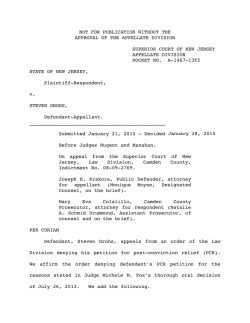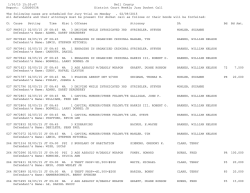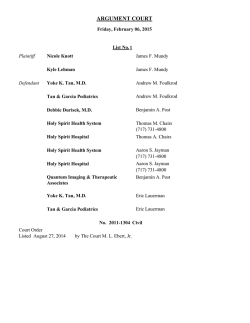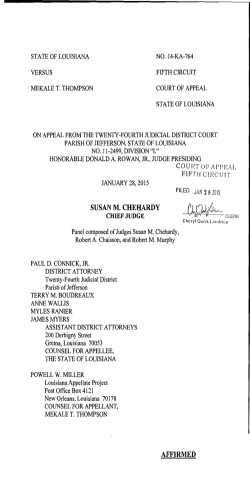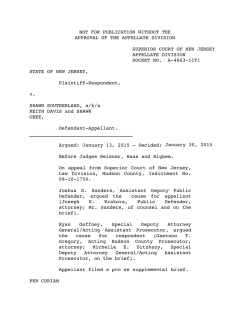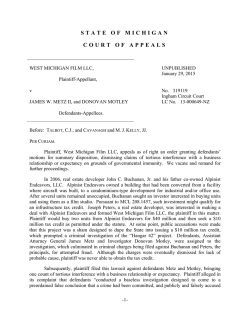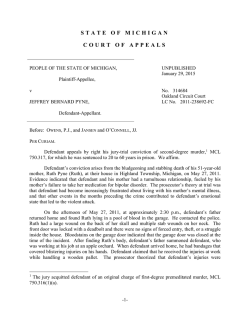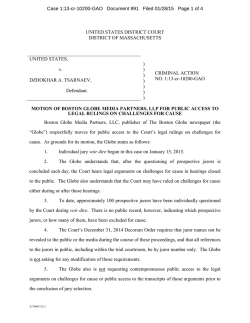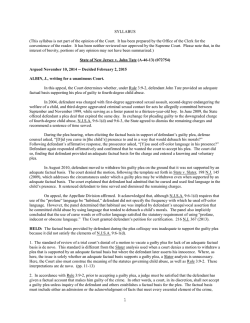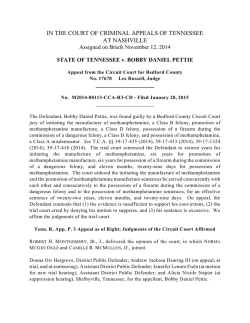
State v. Hill - Fifth Circuit Court of Appeal
STATE OF LOUISIANA NO. 14-KA-748 VERSUS FIFTH CIRCUIT ERIC HILL COURT OF APPEAL STATE OF LOUISIANA ON APPEAL FROM THE TWENTY-FOURTH JUDICIAL DISTRICT COURT PARISH OF JEFFERSON, STATE OF LOUISIANA NO. 11-4603, DIVISION "E" HONORABLE JOHN J. MOLAISON, JR., JUDGE PRESIDING January 28, 2015 COURT OF 1\ FIFTH CI f\' FILED P!J;,~:\ I, .. i '; J.L\N 2 8 2015 JUDE G. GRAVOIS JUDGE Panel composed of Judges Fredericka Homberg Wicker, Jude G. Gravois, and Hans J. Liljeberg PAUL D. CONNICK, JR. DISTRICT ATTORNEY Twenty-Fourth Judicial District Parish of Jefferson TERRY M. BOUDREAUX Al\TDREAF. LONG JEROME G. SMITH, III ASSISTANT DISTRICT ATTORNEYS 200 Derbigny Street Gretna, Louisiana 70053 COUNSEL FOR PLAINTIFF/APPELLEE JANE L. BEEBE ATTORNEY AT LAW Louisiana Appellate Project Post Office Box 6351 New Orleans, Louisiana 70174-6351 COUNSEL FOR DEFENDANT/APPELLANT AFFIRMED; REMANDED FOR CORRECTION OF THE COMMITMENT Defendant, Eric Hill, appeals his conviction and sentence for possession of cocaine in excess of28 to 200 grams, in violation of La. R.S. 40:967(F), which resulted from a guilty plea entered under the provisions of State v. Crosby, 338 So.2d 584 (La. 1976).1 For the reasons that follow, we affirm defendant's conviction and sentence and remand the matter for correction of the commitment. PROCEDURAL HISTORY The procedural history of this case was set forth in this Court's opinion in defendant's first appeal, State v. Hill, 13-447 (La. App. 5 Cir. 12/12/13), 131 So.3d 354, 355, to-wit: On September 14, 2011, the Jefferson Parish District Attorney filed a bill of information charging defendant, Eric Hill, with possession of "[c]ocaine in excess of 28 to 200 grams," in violation of LSA-R.S.40:967(F). He pled not guilty at arraignment. Thereafter, defendant filed various pre-trial motions, including motions to suppress the evidence and statement. A suppression hearing was held on February 1,2012, and the trial court denied defendant's motions to suppress the evidence and statement. I The court in Crosby determined that no statutory or constitutional authority barred it from considering on an appeal from a conviction and sentence founded upon a plea of guilty, an assignment of error properly reserved for review at the time of (a) the trial court ruling, (b) the plea of guilty, and (c) the appeal. Crosby, 338 So.2d at 588. -2 On February 19,2013, defendant withdrew his not guilty plea and entered a guilty plea pursuant to the provisions of State v. Crosby, supra, which allows a defendant to plead guilty while reserving the right to appeal a pre-trial ruling. Defendant was sentenced to 15 years imprisonment at hard labor with the first five years of the sentence to be served without benefit of probation, parole or suspension of sentence. On this same date, the State filed a multiple offender bill of information alleging that defendant was a second felony offender. After defendant stipulated to the allegations in the multiple bill,' his original sentence was vacated, and he was resentenced as a second felony offender to the same sentence of 15 years imprisonment at hard labor, with the first five years of the sentence to be served without benefit of probation, parole or suspension of sentence. (Internal footnote added.) In defendant's first appeal, he assigned as error the trial court's denial of his motion to suppress the evidence. However, this Court vacated and set aside defendant's conviction on other grounds. Hill, 131 So.3d at 355. Instead, this Court found that it was "unclear that defendant intended to plead guilty to possession of 28 to 200 grams of cocaine, as opposed to possession with intent to distribute cocaine." Accordingly, this Court set aside defendant's guilty plea, vacated his conviction and sentence, and remanded the matter to the trial court for further proceedings. Hill, 131 So.3d at 356-57. Further, this Court stated that it would not address the merits of defendant's appeal at that stage of the proceedings. On April 7,2014, defendant withdrew his plea of not guilty and pled guilty, again under Crosby, to possession of between 28 and 200 grams of cocaine. After waiving sentencing delays, defendant was immediately resentenced to 15 years imprisonment at hard labor, with the first five years to be served without the benefit of probation, parole, or suspension of sentence. The trial court ordered defendant's sentence to run concurrently with any other sentence he was currently serving.' Defendant's stipulation to the multiple bill ofinfonnation was also pursuant to Crosby. The court further ordered defendant to pay all court costs, fmes, and fees within 180 days. The court also ordered that defendant relinquish his State driver's license and receive a temporary driving permit, 2 3 -3 On that same day, the State filed an amended multiple offender bill of information, alleging that defendant was a second felony offender. Defendant stipulated, under Crosby, to the multiple offender bill. Defendant's original sentence was vacated, and he was sentenced as a second felony offender to fifteen years imprisonment at hard labor, without the benefit of probation or suspension of sentence. The trial court ordered that defendant's sentence was to run concurrently with all sentences he was currently serving. On June 27, 2014, defendant filed an application for post-conviction relief requesting an out-of-time appeal, which was granted on July 1,2014. This appeal followed. FACTS Defendant pled guilty to possession of cocaine in excess of 28 to 200 grams instead of proceeding to trial. On April 7, 2014, during the guilty plea colloquy, the State provided the following factual basis for the plea: "on or about August 15th, 2011, [defendant] did possess cocaine in excess of twenty-eight grams but less than two hundred grams in Jefferson Parish." Further, the bill of information states that on or about August 15,2011, defendant violated La. R.S. 40:967(F) "in that he did knowingly or intentionally possess a controlled dangerous substance, to wit: Cocaine in excess of 28 to 200 grams." ASSIGNMENT OF ERROR Denial ofmotion to suppress the evidence In his only assignment of error, defendant argues that the trial court should have granted his motion to suppress the evidence because the officers lacked probable cause to arrest him or even a reasonable suspicion to justify an investigatory stop. Defendant asserts that labeling a neighborhood a high-crime area alone is not sufficient. Defendant argues that walking back into a courtyard as -4 a marked police unit passed by was not indicative of a crime or perceived flight from the patrol vehicle. Defendant notes that the officers admitted that they did not observe any criminal activity. Defendant argues that even if there was a lawful stop, the officers were not justified in handcuffing and frisking him. Defendant asserts that the vehicle where drugs were discovered was never alleged to have been used in furtherance of criminal activity or to be near defendant at the time of his arrest. The State responds that the trial court properly denied defendant's motion to suppress the evidence. The State argues that the officers had a reasonable suspicion to conduct an investigatory stop based on citizen complaints, the highcrime nature of the area, the officers' observations of suspicious activity consistent with narcotics trafficking, and the subjects' suspicious actions upon viewing a marked police vehicle on the scene. The State asserts that even without a legal basis for the initial police interaction, suppression would not be warranted because the officers determined that defendant had an outstanding attachment for his arrest. The State concludes that the officers lawfully seized the evidence recovered after defendant's arrest. The suppression hearing On February 1,2012, a hearing was conducted on defendant's motion to suppress the evidence.' At the hearing, Sergeant Richard Dykes of the Jefferson Parish Sheriffs Office testified that on August 15,2011, investigators were conducting surveillance in the 2400 block of Alex Korman Boulevard in Jefferson Parish. Sergeant Dykes testified that the location was a high-crime area where officers had received complaints of narcotics trafficking. Sergeant Dykes testified that investigators observed several subjects meeting at the location with some 4 Defendant's motion to suppress statement was also simultaneously heard and denied during this hearing. However, defendant does not complain of the denial of the motion to suppress statement in this appeal. -5 vehicles, and he and other officers elected to conduct stops to discover what was going on at the location. In particular, Sergeant Dykes testified that he received information over the radio that an officer in a marked patrol car observed several subjects step back into a courtyard area between two buildings when they saw the marked patrol unit drive by. Sergeant Dykes testified that this behavior by the subjects led to the initial stop. Sergeant Dykes testified that after arriving at the location, he approached and spoke to defendant, learned his name, discovered that he had an outstanding attachment for his arrest, arrested him on that attachment, and advised him of his Miranda: rights. Sergeant Dykes testified that he also received information that defendant was connected to or was seen exiting a silver pick-up truck. Sergeant Dykes testified that during a search of defendant incident to his arrest, he found keys to the silver pick-up truck and a little over $4,000.00 in cash on defendant's person. Sergeant Dykes testified that defendant stated that he had around $2,000.00 on him in order to purchase a vehicle. Sergeant Dykes also testified that defendant did not indicate that he was employed. On cross-examination, Sergeant Dykes agreed that the section of Alex Korman Boulevard in question is a wide street where apartment buildings are bunched together for a few blocks, many cars are parked there with some vehicles parked one behind the other, and sometimes dozens of people are outside of their apartments sitting, talking, loitering, or hanging out. Sergeant Dykes testified that he heard a radio transmission that when Detective Carl Koppeis drove past the location in a marked patrol unit, the subjects "went from out in front to behind the brick wall in the courtyard." Sergeant Dykes testified that Detective Koppeis did not name the subjects or describe their clothing during the radio transmission. 5 Miranda v. Arizona, 384 U.S. 436, 86 S.Ct. 1602, 16 L.Ed.2d 694 (1966). -6 Sergeant Dykes testified that he stopped defendant based on the radio transmission because defendant was walking by the courtyard that was described by Detective Koppeis. Sergeant Dykes agreed that he was unsure whether Detective Koppeis was referring to defendant. Sergeant Dykes testified that he previously observed defendant getting out of a silver pick-up truck. Detective Henry Conravey of the Jefferson Parish Sheriffs Office Street Crimes Unit testified that he was present on the scene when Sergeant Dykes arrested defendant, and that he looked through the driver's side window of defendant's vehicle. Detective Conravey testified that he observed "a clear Ziploc type baggy sitting on the driver's seat, sort of next to the center console. It had a white powder in it that appeared consistent with cocaine, powder cocaine." Detective Conravey also testified that he observed other potential contraband on the front passenger seat of the vehicle, including a clear plastic measuring cup and a "cell phone" that turned out to be a digital scale. On cross-examination, Detective Conravey testified that he was conducting surveillance in an unmarked car. Detective Conravey agreed that the 2400 block of Alex Korman Boulevard has a line of apartments that are detached and semi detached, and that there is a parking lot between the apartments and the street. The detective agreed that there are often people outside talking, visiting, and loitering, depending on the time of day. Detective Conravey testified that he left his surveillance position because of the radio transmission he heard that three subjects standing in front of the location "ducked" into the courtyard upon seeing the officer drive by the location in a marked patrol unit. He testified that he did not observe any specific crimes committed. Detective Conravey testified that during his surveillance, he observed suspicious activity. He testified that he observed several people loitering outside -7 of 2473 Alex Korman Boulevard. He saw several vehicles pull up to the location for very short periods of time. Subjects walked to the vehicles and then walked back to the courtyard. Detective Conravey testified that in his experience, those actions were "very consistent with narcotics trafficking." Detective Conravey testified that he was unable to see what the subjects were doing because the vehicles that pulled up were between the subjects and where the officers had set up surveillance. He did not observe any hand-to-hand transactions. Detective Conravey testified that prior to the radio transmission, he observed defendant drive up in his vehicle. He testified that when he arrived at the location, Sergeant Dykes was in the process of conducting a "pat-down" search of defendant in front of a police car in the parking lot. At the hearing, defense counsel argued that the officers' testimony failed to show a sufficient reason for a Terry stop. Defense counsel asserted that both officers admitted that they did not see defendant commit a crime, and the second officer testified that he only saw defendant exit a vehicle. Defense counsel argued that the officers' testimony failed to include the suspicions that led them to detain defendant. Defense counsel argued that defendant's presence in a high crime area was not a sufficient reason to stop him. Defense counsel also argued that the officers' testimony failed to connect defendant with any suspicious activity. Analysis The Fourth Amendment to the United States Constitution and Article 1, § 5 of the Louisiana Constitution prohibit unreasonable searches and seizures. If evidence is derived from an unreasonable search or seizure, the proper remedy is exclusion of the evidence from trial. Warrantless searches and seizures are per se unreasonable unless justified by one of the exceptions to the warrant requirement. 6 Terry v. Ohio, 392 U.S. 1,88 S.Ct. 1868,20 L.Ed.2d 889 (1968). -8 State v. Wolff, 09-508 (La. App. 5 Cir. 12/29/09),30 So.3d 897, 901. The State bears the burden of proof in establishing the admissibility of evidence seized without a warrant. The trial court's decision to deny a motion to suppress is afforded great weight and will not be set aside unless the preponderance of the evidence clearly favors suppression. State v. Huntley, 10-406 (La. App. 5 Cir. 1/25111), 60 So.3d 644, 650-51 (citing La. C.Cr.P. art. 703(D); and State v. Honeycutt, 08-126 (La. App. 5 Cir. 5/27/08),987 So.2d 250, 253-54). Officers have a right to engage anyone in conversation, even without reasonable suspicion to believe that they have committed a crime. State v. Alberti, 13-205 (La. App. 5 Cir. 10/09113),128 So.3d 351,356,358. As such, in the present case, we need not address the question of whether the officers had reasonable suspicion to conduct a Terry stop. In the present case, Sergeant Dykes testified that after arriving at the location, he approached defendant, learned his name, discovered that he had an outstanding attachment, and arrested him on that attachment. Upon review, we find that the officer had the right to approach defendant and ask him a question, even without reasonable suspicion to believe that he had committed a crime. See Alberti, 128 So.3d at 358. When the officer learned that defendant had an outstanding attachment for his arrest, he arrested defendant on the attachment. Defendant was then searched pursuant to the arrest, which is an exception to the warrant requirement, and his vehicle's keys were found on his person. Defendant further argues that the evidence seized in his vehicle was illegally obtained because the vehicle was not near enough to defendant to be included in a search incident to the arrest, and the vehicle was never alleged to have been used in furtherance of a crime. However, we find that the officers had probable cause to justify a warrantless search of the vehicle under the "plain view" doctrine. See -9 Williams, 47 So.3d at 473 (citing State v. Joseph, 02-717 (La. App. 5 Cir. 6/27/03), 850 So.2d 1049, writ denied, 04-2404 (La. 6/17/05), 904 So.2d 686). The Fourth Amendment to the United States Constitution generally requires police to secure a warrant before conducting a search. In an exception thereto, police may lawfully seize evidence without a warrant under the "plain view" doctrine when: 1) there is prior justification for an intrusion into the protected area; and 2) it is immediately apparent, without close inspection, that the items seized are evidence or contraband. Morales, 125 So.3d at 1147 (citing State v. Tate, 09 619 (La. App. 5 Cir. 2/9110), 33 So.3d 292,300-01 (citations omitted)). "Under the plain view doctrine, if police are lawfully in a position from which they view an object that has an incriminating nature that is immediately apparent, and if the officers have a lawful right of access to the object, they may seize it without a warrant." Morales, supra (citing State v. Leger, 05-0011 (La. 7110/06), 936 So.2d 108,155, cert. denied, 549 U.S. 1221,127 S.Ct. 1279, 167 L.Ed.2d 100 (2007) (citations omitted)). In Morales, 125 So.3d at 1144-45, as an officer was patrolling a high-crime, high-narcotics area in a marked police vehicle, she observed the defendant slouch down in the front passenger seat as she drove by. According to the officer, she suspected the defendant was attempting to hide something and might be committing a crime, such as vehicle burglary or drug possession. When the officer instructed the defendant to exit the vehicle, the defendant placed a clear plastic bag of white powder consistent with cocaine in the door handle. The defendant also had an outstanding attachment, and the officer arrested him based on the attachment. The officer searched the defendant and found a cigarette containing green matter. She also seized the plastic bag of white powder from the vehicle. Morales, supra. -10 On appeal, the defendant argued that the trial court erred in denying his motion to suppress the evidence. Morales, 125 So.3d at 1145. This Court found that the officer had a right to be standing outside the vehicle when she observed the cocaine, which was immediately apparent as contraband. Morales, 125 So.3d at 1146-48. This Court further found that the cocaine was lawfully seized pursuant to the plain view exception to the warrant requirement. Morales, 125 So.3d at 1148. In the present case, while conducting surveillance in a high-crime, high narcotics area, Detective Conravey observed defendant pull up to the area and exit his vehicle. In a search incident to the arrest of defendant, which occurred shortly after defendant pulled up, Sgt. Dykes found over $4,000.00 in cash and the vehicle's keys on defendant's person. While defendant was being arrested, Detective Conravey subsequently observed narcotics and drug paraphernalia on the front seats of defendant's vehicle in plain view without opening the vehicle's door. There was no evidence that the vehicle was associated with any other person on the scene other than defendant. Upon review, we find that Detective Conravey was justified in being present in the area where he observed the narcotics and drug paraphernalia, which were located on the front seats of defendant's vehicle and were immediately apparent as contraband. Thus, we find that the evidence was lawfully seized pursuant to the plain view exception to the Fourth Amendment's requirement for a search warrant. Therefore, we find that there was no error in the trial court's denial of defendant's motion to suppress the evidence. See Morales, 125 So.3d at 1148. Based on the foregoing, we find that defendant's assignment of error is without merit. -11 ERRORS PATENT REVIEW The record was reviewed for errors patent, according to La. C.Cr.P. art. 920, State v. Oliveaux, 312 So.2d 337 (La. 1975), and State v. Weiland, 556 So.2d 175 (La. App. 5 Cir. 1990). The following patent error merits attention. The record reveals a conflict between the transcript and the "State of Louisiana Uniform Commitment Order," which reflects the incorrect date ofthe adjudication and sentence. The Uniform Commitment Order incorrectly reflects the adjudication date and sentencing date as February 19, 2013, which was the date of defendant's previous conviction that was vacated by this Court in defendant's first appeal. The record reflects that defendant again pled guilty and stipulated to being a multiple offender on April 7, 2014. Accordingly, we remand this matter for correction of the Uniform Commitment Order regarding the adjudication and sentencing dates and further direct the Clerk of Court to transmit the original of the corrected Uniform Commitment Order to the officer in charge of the institution to which defendant has been sentenced and the Department of Corrections' legal department. State v. Lyons, 13-564 (La. App. 5 Cir. 1/31/14), 134 So.3d 36 (citing State v. Long, 12-184 (La. App. 5 Cir. 12/11/12), 106 So.3d 1136, 1142, and State ex rel. Roland v. State, 06-224 (La. 9/15/06), 937 So.2d 846 (per curiam)); see also La. C.Cr.P. art. 892(B)(2). CONCLUSION For the foregoing reasons, defendant's conviction and sentence are affirmed. The matter is remanded for correction of the commitment as noted herein. AFFIRMED; REMANDED FOR CORRECTION OF THE COMMITMENT -12 SUSAN M. CHEHARDY CHERYL Q. LANDRIEU CHIEF JUDGE CLERK OF COURT MARY E. LEGNON FREDERICKA H. WICKER JUDE G. GRAVOIS MARC E. JOHNSON ROBERT A. CHAISSON ROBERT M. MURPHY STEPHEN J. WINDHORST HANS J. LIUEBERG JUDGES CHIEF DEPUTY CLERK SUSAN BUCHHOLZ FIRST DEPUTY CLERK FIFTH CIRCUIT 101 DERBIGNY STREET (70053) MELISSA C. LEDET DIRECTOR OF CENTRAL STAFF POST OFFICE BOX 489 GRETNA, LOUISIANA 70054 (504) 376-1400 (504) 376-1498 FAX www.fifthcircuit.org NOTICE OF JUDGMENT AND CERTIFICATE OF DELIVERY I CERTIFY THAT A COpy OF THE OPINION IN THE BELOW-NUMBERED MATTER HAS BEEN DELIVERED IN ACCORDANCE WITH Uniform Rules - Court of Appeal, Rule 2-20 THIS DAY JANUARY 28.2015 TO THE TRIAL JUDGE, COUNSEL OF RECORD AND ALL PARTIES NOT REPRESENTED BY COUNSEL, AS LISTED BELOW: or, /1 r- 1 1 r\ l \'•.1:-/ .,jvv'lft1J,J0?~J4J/~ eMERYL Q. e'ANDRfEU CLERK OF COURT 14-KA-748 E-NOTIFIED TERRY M. BOUDREAUX ANDREA F. LONG MAILED JANE L. BEEBE ATTORNEY AT LAW LOUISIANA APPELLATE PROJECT POST OFFICE BOX 6351 NEW ORLEANS, LA 70174-6351 HON. PAUL D. CONNICK, JR. DISTRICT ATTORNEY JEROME G. SMITH, III ASSISTANT DISTRICT ATTORNEY TWENTY-FOURTH JUDICIAL DISTRICT 200 DERBIGNY STREET GRETNA, LA 70053
© Copyright 2025
